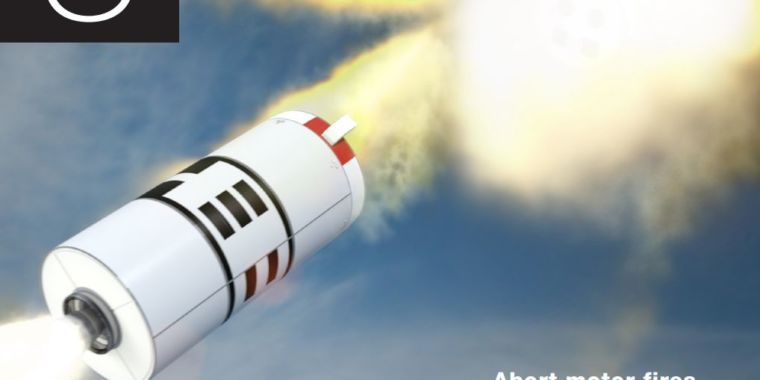https://arstechnica.com/?p=1529509

-
Orion and its solid rocket on the launch pad Monday morning at Cape Canaveral Air Force Base.
Trevor Mahlmann
-
The test version of Orion attached to the Launch Abort System for the Ascent Abort-2 (AA-2) flight test is hoisted up by crane at Space Launch Complex 46 at Cape Canaveral Air Force Station.
-
NASA, Air Force, and industry partners pause for a team photo in front of the stacked Abort Test Booster and Orion.
NGIS
-
Orion, with its Launch Abort System, is lifted for mating to a decommissioned Peacekeeper ICBM for the Ascent Abort test.
NGIS
Nearly five years have passed since NASA first launched its Orion spacecraft to an apogee of 5,800km above the Earth, completing a successful test flight of the capsule intended to carry astronauts to lunar orbit in the 2020s.
Now, NASA is preparing for its second Orion launch, although this flight will be considerably shorter. On Tuesday morning, NASA intends to launch a boilerplate version of Orion—essentially a well instrumented vehicle without any life-support equipment or many other critical systems—on top of a solid rocket booster built by Northrop Grumman.
The rocket is actually an old Peacekeeper intercontinental ballistic missile, now refurbished for commercial purposes. It will launch the Orion to an altitude of nearly 9.5km above the Florida coast in order to test Orion’s launch abort system at the point of maximum dynamic pressure. This will occur about 55 seconds after launch.
“This will simulate a really bad day for Orion, where there’s a problem with the launch vehicle at the worst possible moment,” said Orion Program Deputy Manager Charlie Lundquist in an interview with Ars.
A violent shock
The capsule’s escape from an exploding launch vehicle involves three steps. When Orion reaches its test altitude, the spacecraft’s launch abort system—which resides in a tower above the capsule—will first fire its powerful abort motor to rapidly pull the spacecraft away from the rocket. This will be a violent shock for the vehicle, and NASA engineers are keen to understand the forces the abort motor firing will generate inside Orion—and also to understand how robust engineers will need to build critical components used during crew flights.
A few seconds later, an attitude control motor at the top of the launch abort system will fire to stabilize Orion and orient it properly so that the spacecraft can be released. Finally, a jettison motor will fire to release Orion so that its drogue parachutes can open, followed by its main parachutes, before the spacecraft splashes down in the Atlantic Ocean.
-
This gallery highlights the phases of the three-minute test of Orion’s launch abort system.
NASA
-
The launch abort system is the tower at the top of the capsule.
NASA
-
The launch will be slow, as the rocket motor is pushing a lot of weight.
NASA
-
At 55 seconds the excitement begins.
-
Then the capsule must be reoriented for a safe return to Earth.
NASA
-
Then the capsule is released from the launch abort system.
NASA
-
First the drogue chutes, then the mains come out. NASA will not seek to recover this capsule.
NASA
The whole test will last only about 3 minutes. “I wouldn’t blink,” Lundquist said. “When the launch window opens, I wouldn’t take a bathroom break.”
The test’s four-hour launch window opens at 7:00am ET (11:00 UTC) on Tuesday, July 2. From a hardware perspective, Lundquist said NASA has checked out all of the systems after integrating Orion with its rocket and that everything looks good. The primary concern is weather, with the potential for rainfall. However, NASA just needs a few minutes of good visibility to obtain good video data during the test.
“We need to fly”
Back in 2010, NASA conducted another test of the launch abort system—a pad abort test that simulated a failure of the rocket on the ground. During this test, Orion could not escape high enough into the atmosphere to have time to deploy its drogue parachutes, so it went right into main parachute deployment.
Since that time the launch abort system has evolved due to the changing nature of Orion’s rocket. In 2010, NASA had planned to launch Orion on an Ares I rocket, which was powered by a solid rocket motor that would ascend more rapidly than the larger Space Launch System, which itself has a combination of liquid fueled rocket engines and solid motor propulsion.
NASA has now been developing Orion in various configurations for nearly 15 years and has spent about $16 billion on the program. At various times the capsule has been tagged as a Mars transit vehicle, a Moon vehicle, a lifeboat from the International Space Station, and more. Now, NASA hopes to use the large and capable spacecraft as a means of getting crews safely to a small station near the Moon, called the Lunar Gateway, which the space agency hopes to build in the early 2020s.
Lundquist acknowledged that it will be good to get Orion flying again, even if its next spaceflight probably won’t occur for another couple of years—likely in 2021 during a test flight of the Space Launch System rocket. “We need to fly,” he said. “We need to show progress. This is a big morale boost to the team to demonstrate the human rated capability of the Orion spacecraft.”
via Ars Technica https://arstechnica.com
July 1, 2019 at 07:36AM
